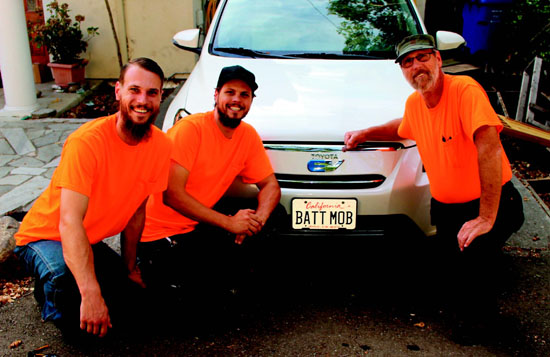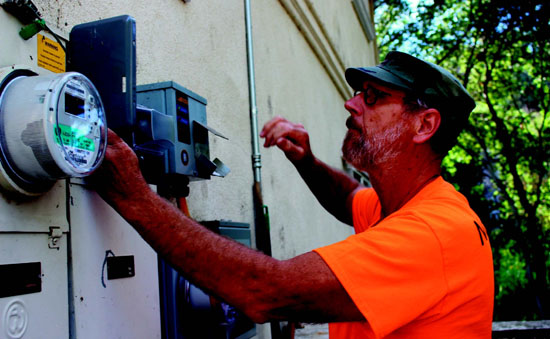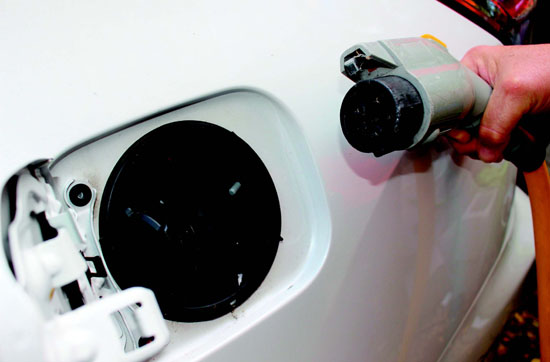 |
|
|
At Norseman it's a family affair with sons Darryl and Travis Johnson working alongside their father, Randy. Their Lafayette client sports their favorite license plate. Photo Chris Lavin
|
|
|
|
|
|
Far gone are the days when Fred Flintstone powered a car with his feet. Also gone are the days of the giant gasoline guzzlers of "American Graffiti." Welcome, now, to the days of volts and amps.
 The large national and also very much local trend toward going electric turns out not to be as simple as running an extension cord out to the driveway. While there used to be a time when an electric car could be plugged in to just about any outlet, times have changed. Today's cars need big power for fast charging. Most require the installation of electric vehicle supply equipment, or EVSE in the parlance of the day. And unless care is taken, the supply chain can get hot, quite literally.
The large national and also very much local trend toward going electric turns out not to be as simple as running an extension cord out to the driveway. While there used to be a time when an electric car could be plugged in to just about any outlet, times have changed. Today's cars need big power for fast charging. Most require the installation of electric vehicle supply equipment, or EVSE in the parlance of the day. And unless care is taken, the supply chain can get hot, quite literally.
 "When Chevy Volts came in they were catching fire in the garage," said Gint Federas of Lafayette, a photographer for Lamorinda Weekly who has owned a variety of electric cars. "Sometimes the most simple way to charge is not the most efficient."
"When Chevy Volts came in they were catching fire in the garage," said Gint Federas of Lafayette, a photographer for Lamorinda Weekly who has owned a variety of electric cars. "Sometimes the most simple way to charge is not the most efficient."
 While the Moraga-Orinda Fire District hasn't seen any house fires start directly because of electric car issues, special trainings about car fires have started to incorporate concerns about how people are "heating up" their garages.
While the Moraga-Orinda Fire District hasn't seen any house fires start directly because of electric car issues, special trainings about car fires have started to incorporate concerns about how people are "heating up" their garages.
 "We haven't seen any fires directly because of that," said MOFD firefighter-paramedic Brittany McMahon. "But people can't plug their cars into a regular outlet. It's definitely a new thing."
"We haven't seen any fires directly because of that," said MOFD firefighter-paramedic Brittany McMahon. "But people can't plug their cars into a regular outlet. It's definitely a new thing."
 When you find yourself among electricians and savvy electric car owners, it is easy to check out of the conversation. There is talk of amps and wattage. There is talk of overload. Talk of circuit breaks. Talk of bypasses and breakers. One finds oneself thinking "What's for dinner?" while talk of applications of electricity and circuitry abound. Electrician Randy Johnson breaks into this line of culinary thinking by saying, "Yeah, that can start a fire."
When you find yourself among electricians and savvy electric car owners, it is easy to check out of the conversation. There is talk of amps and wattage. There is talk of overload. Talk of circuit breaks. Talk of bypasses and breakers. One finds oneself thinking "What's for dinner?" while talk of applications of electricity and circuitry abound. Electrician Randy Johnson breaks into this line of culinary thinking by saying, "Yeah, that can start a fire."
 "What?" Turns out that, yeah, bad circuitry can start a fire.
"What?" Turns out that, yeah, bad circuitry can start a fire.
 "It's a learning curve," said his son, Travis Johnson, who works for the family business. An electric car driver must traverse that curve. Some cars might have the battery capacity to drive for a day, but the supply on the home end will require two days to charge. Early electric cars with the smallest batteries would limit their range to a 50-mile radius.
"It's a learning curve," said his son, Travis Johnson, who works for the family business. An electric car driver must traverse that curve. Some cars might have the battery capacity to drive for a day, but the supply on the home end will require two days to charge. Early electric cars with the smallest batteries would limit their range to a 50-mile radius.
 "You really had to plan the trips," Federas said.
"You really had to plan the trips," Federas said.
 Now there are bigger batteries, and more complicated computer systems. Whether one chooses a Tesla, a Nissan LEAF, a Volt or other brand, new electric cars come with a charging package that may well require rewiring a garage, an outside charging port, or both.
Now there are bigger batteries, and more complicated computer systems. Whether one chooses a Tesla, a Nissan LEAF, a Volt or other brand, new electric cars come with a charging package that may well require rewiring a garage, an outside charging port, or both.
 A new electric car owner today has to know how big and how strong his or her battery is and how long it will last. Onboard computers help owners know how much and how long they have left, and the computers let them know when they need to dock in. But again, it is not just a plug in the wall.
A new electric car owner today has to know how big and how strong his or her battery is and how long it will last. Onboard computers help owners know how much and how long they have left, and the computers let them know when they need to dock in. But again, it is not just a plug in the wall.
 "It's a lot like plugging your phone into its docking station," said Federas. If the phone runs out of power, no calls come in. If the car runs out of power, no turning the ignition; you are dead in the road.
"It's a lot like plugging your phone into its docking station," said Federas. If the phone runs out of power, no calls come in. If the car runs out of power, no turning the ignition; you are dead in the road.
 By using EVSE, the whole system will monitor how much charge the car battery can take, as well as how much power there is to be had. In many cases plugging in at Whole Foods or the hardware store, at BART or stores that offer free charging while shopping will be different than plugging in at home.
By using EVSE, the whole system will monitor how much charge the car battery can take, as well as how much power there is to be had. In many cases plugging in at Whole Foods or the hardware store, at BART or stores that offer free charging while shopping will be different than plugging in at home.
 "It depends on where you are," Randy Johnson said. "Different docks come with different specifications." Some Tesla owners, he said, carry a plethora of adapters to be able to plug into whatever outlet is available.
"It depends on where you are," Randy Johnson said. "Different docks come with different specifications." Some Tesla owners, he said, carry a plethora of adapters to be able to plug into whatever outlet is available.
 Another thing to consider is when to charge the car. Pacific Gas and Electric Co. has peak hours. Even though driving by electricity is cheaper than buying gasoline, charging the car during peak hours can cost twice as much as charging on the off hours - so most electric car owners charge the car while they are asleep. Some owners use timers on the systems themselves; the more modern cars utilize on-board systems to know when to "turn on" to charge.
Another thing to consider is when to charge the car. Pacific Gas and Electric Co. has peak hours. Even though driving by electricity is cheaper than buying gasoline, charging the car during peak hours can cost twice as much as charging on the off hours - so most electric car owners charge the car while they are asleep. Some owners use timers on the systems themselves; the more modern cars utilize on-board systems to know when to "turn on" to charge.
 Other drivers have applications on their personal devices that will allow them to monitor the use of their electricity by the minute. "Yay!" they will say while watching Netflix, when a window appears in the corner of the screen. "The car just came on."
Other drivers have applications on their personal devices that will allow them to monitor the use of their electricity by the minute. "Yay!" they will say while watching Netflix, when a window appears in the corner of the screen. "The car just came on."
 Ready to go in the morning.
Ready to go in the morning.

|


